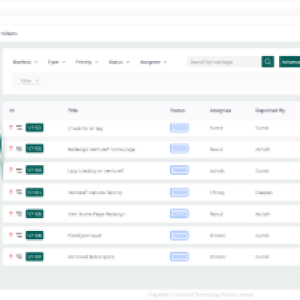Effective Project Backlog Management: Techniques and Tools to Keep Your Team on Target
Project backlog management is the process of prioritizing, organizing, and managing the tasks required to complete a project. It is a vital aspect of effective project management, as it helps to ensure that work is focused on the most important tasks and that the team stays on target and on schedule. However, managing a backlog can be a complex and challenging task, especially for large and complex projects. To keep your team on target, effective project backlog management techniques and tools are essential.
-
Prioritization: One of the most critical aspects of effective project backlog management is prioritization. By identifying the most important tasks and focusing on them first, the team can ensure that progress is made on the most important and impactful aspects of the project. Prioritization can be done using techniques such as MoSCoW (Must have, Should have, Could have, Won’t have) or Kano analysis.
-
Task Breakdown: Another important technique for project backlog management is task breakdown. By breaking larger tasks into smaller, more manageable chunks, the team can better understand the work required and make better-informed decisions about what tasks should be prioritized.
-
Tracking Progress: It's important to have a system in place to track the progress of tasks in the backlog, this can be done through software tools such as Trello, JIRA, or Asana, which provide clear visibility into the status of tasks and help teams to identify and address any issues that arise.
-
Collaboration: Effective project backlog management also requires collaboration between team members, stakeholders, and managers. By involving team members in the process of prioritizing and managing tasks, organizations can ensure that everyone is working towards the same goals and that the backlog reflects the needs and priorities of the entire team.
-
Tools: There are several software tools that can help teams to manage their backlogs more effectively. These tools typically provide features such as task prioritization, task breakdown, tracking progress, and collaboration. Some of the most popular tools include Trello, Jira, and Asana.
Using Backlogs to Stay On Track and On Budget
Project backlog management is a key element of efficient project management, it allows teams to prioritize and organize the tasks required to complete a project, stay on track and on budget. The backlog serves as a roadmap for the project and ensures that the team is focused on the most important and impactful tasks. However, managing a backlog can be a complex and challenging task, especially for large and complex projects. Here are some strategies to help stay on track and on budget:
-
Prioritization: One of the most critical aspects of efficient project backlog management is prioritization. By identifying the most important tasks, and focusing on them first, the team can ensure that progress is made on the most impactful aspects of the project. Prioritization can be done using techniques such as MoSCoW (Must have, Should have, Could have, Won’t have) or Kano analysis.
-
Time and Resource Planning: Efficient project management requires an accurate estimate of the time and resources required to complete each task in the backlog. By having a clear understanding of how much time and resources are required, teams can better plan their work and stay on schedule.
-
Regular Reviews: Regular reviews of the backlog are necessary to ensure that the project is still on track and budget. Reviews should be done regularly, at least every sprint or month, to identify any issues or changes in priorities and make adjustments accordingly.
-
Automation: Automation can play an important role in efficient project backlog management. Automation can help to streamline processes and minimize the time and resources required to manage the backlog.
-
Risk Management: A good backlog management includes a regular review of the risks and mitigation plans that are associated with the tasks in the backlog. By managing risks early on, it is possible to prevent them from becoming problems that can derail the project.
In conclusion, efficient project management requires an effective approach to project backlog management. By using backlogs to prioritize and organize tasks, plan time and resources, and review progress, teams can stay on track and on budget throughout the project. Additionally, automation and risk management can play a critical role in streamlining the process and preventing issues from arising.




